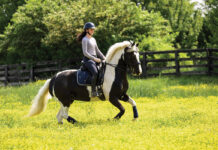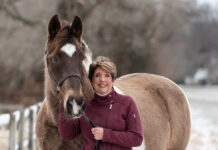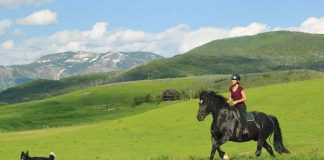 In nature, dogs and horses would not be pals. It’s through domestication and humans’ sometimes-unreasonable wishes that they are asked to coexist in today’s barnyards.
In nature, dogs and horses would not be pals. It’s through domestication and humans’ sometimes-unreasonable wishes that they are asked to coexist in today’s barnyards.
If you own equines and canines, and are coping with compatibility issues, here are some training tips to help everyone in the barn get along.
A Dog’s First Encounter
When introducing a “green” dog to horses, experts say you need to begin, well, at the beginning. The first between-species meeting is going to set the tone for the relationship.
“Pick a horse that’s dog savvy for the first meeting,” says Pam Dennison, veteran dog trainer and founder of Positive Motivation Dog Training in Belvidere, N.J.
Dennison uses horses that won’t react to a dog that’s barking or behaving nervously. The idea is similar to pairing a green rider with a seasoned horse—at least one of them knows the drill.
If you can do this exercise while the dog is still a puppy, the introduction will probably go much smoother because a puppy has fewer negative behaviors to un-teach.
Introductions of any kind should start with the dog on a leash. Robert DeFranco, board certified companion animal behaviorist with the Association of Companion Animal Behavior Counselors, suggests putting the dog in a Gentle Leader head collar. Using the head collar, DeFranco says you can control the dog “very easily and very gently.”
The last thing you want is for your dog to get hurt or feel pain by means of inhumane restraint. He will associate that pain with meeting the horse, and this will become a negative experience.
Having the dog under your control is essential because “horses are obviously flight animals, unlike a dog that’s a social animal. You’re going to have a dog coming up to a horse faster than a horse will approach the dog,” DeFranco says.
You don’t want the dog approaching too quickly and spooking the horse, as the dog can feed off that energy and kick into predatory mode, so start from a distance first. “Lots of treats, lots of play, lots of petting to pair good associations with the horse,” says Dennison, who is also a certified dog behavior consultant with the International Association of Animal Behavior Consultants.
As the dog shows you signs that he’s OK with a horse 30 feet away, slowly get closer. When the dog and horse are finally face to face, let them sniff each other. Dogs base much of their judgment on smell, so they need time to know what to make of this large, looming animal.
Don’t let the dog spend too much time sniffing at first. Dogs will often get scared of something they’re not sure of and start barking or get aggressive. So, let him sniff the horse, then call the dog away, give more treats, praise and play, and go back for another short meeting. If you keep the dog busy, you won’t give him time to get scared.
Throughout the process, Dennison cautions, keep it slow. If there is the slightest sign of fear or aggression from the dog, increase your distance, keep up the positive association, and try again.
If the dog does react negatively, it’s important not to punish him. Yelling and punishment can be confusing to a dog, and he will only associate that with the overall experience. Instead, find opportunities to use positive reinforcement and try to pay close attention to your dog’s attitude so you can stop a negative reaction before it starts.
A Dog with a Past
Not everyone brings a dog home as a puppy. If you are considering getting an adult dog from a shelter, his past is probably a mystery. If horses are an important part of your life, the dog you bring home needs to be compatible with them.
“Before bringing a dog home permanently, I’d want to make sure that dog was good with horses,” Dennison points out. “It would be like if you have kids and you get a shelter dog; you’re not going to get one that’s not good with kids.”
Many shelters will let you take the dog for a trial period. That’s a good time to try the introduction exercise with him.
“Get to know the signs and the expressions of your dog and your horse. If you see a problem, stop right then and try to introduce them slowly,” DeFranco says.
If you’re unsure about fear or aggression signs that you need to watch for, ask for assistance from a trainer, veterinarian or behaviorist.
“We’re usually called in when there’s a problem,” DeFranco continues, but he has also been asked to visit a shelter or work with a family in choosing a dog.

Working with Problem Horses
Sometimes it’s not the dog that needs to be slowly introduced to the horse. If there’s a bad canine experience ingrained in a horse’s brain, he’ll need a careful reintroduction to dogs.
The process is similar to the dog’s first meeting with a horse. You want to be sure the dog you choose for the reintroduction is not going to react to the horse’s nervousness.
Start again with the dog on the leash some distance from the horse. Have someone else working with the horse, by feeding treats, grooming, or doing something else that the horse enjoys. This is called operant conditioning.
DeFranco says the horse is thinking, “When this animal [dog] is around things are good, so I’ll tolerate this animal.”
“I think I’ve learned with my work with horses [that they] learn much faster than dogs do,” Dennison says. “What I’ve also learned with horses, every single one of them, is that you cannot use food exclusively as a reward past the first 15-20 minutes of training because they become pushy around food.”
The dog should only approach as the horse remains relaxed. When they are face to face, it’s as important for the horse to sniff the dog and vice-versa. Keep the dog away from the horse’s back legs, and keep an eye on both animals’ body language to gauge whether the situation is about to turn bad.
“The dog’s temperament is critical,” DeFranco says. At this point, if the horse spooks or has a negative reaction, and then the dog reacts negatively, you have to start all over.
Controlling the Environment
Let’s say you’ve brought home a dog that turns out to not be OK with horses. Or maybe you got a dog as a puppy but did everything wrong, so now you can’t trust the dog around the barn. These things happen. You don’t have to get rid of the dog; you just have to control his environment.
“Dogs are naturally inquisitive and will often chase something that runs,” including horses, DeFranco says.
This might be a predatory behavior, or the dog just might be having fun. Either way, you can use certain types of pasture fence to keep out roaming dogs.
If your dog is only a problem during feeding time, feed the horses in the barn with the doors closed so the dog can’t enter.
If the dog nips at a horse’s heels as you’re leading, keep the dog in the house, in a kennel or on a tie-out line while you’re turning out.
Herding “is a behavior that’s instinctively bred into some dogs, but you can train a dog not to herd the horses through behavior modification,” says Lisa Peterson, long-time horse person and American Kennel Club (AKC) spokesperson. “Give the dog another job at the barn. Make sure the dog has enough activity so that he doesn’t invent behaviors on his own.”
If you board your horses make sure that when you bring your dog to the barn, you’re following barn rules.
“Just because your horse is OK with dogs, you shouldn’t assume that other people’s horses are, too,” Peterson says. “A lot of people love to go to the barn and let their dogs run loose,” she continues. “You really need to supervise the dog to make sure he doesn’t roam, get into a fight with neighboring dogs, or frighten a young horse.”
A little bit of effort on your part can go a long way toward having peace in the barnyard between your horses and dogs.
Liked this article? Here are more dog and horse resources:
Choosing a Barn Dog
The Dog and Horse Training Connection
Dogs and Horses
This article originally appeared in the July 2007 issue of Horse Illustrated. Click here to subscribe.







Thanks for the info!
This is really good information! Wil have to try it with my King-size German Shepherd! He tends to enjoy chasing our one horse Barley and then Barley starts chasing him, as well as bucking and kicking…. not fun…
I just read the related article in HI. Perfect timing for me because I just got a puppy that I want to be able to take out with my horse on a regular basis. My dog is nervous around the horse and the horse likes to attack dogs but they’re warming up to each other.
My dog hates horses he almost got kicked by horses at least 3 times but i think i will try this because it sounds as if it will work.
Yeah, my dog would probably freak out if he saw a horse, but I hope not. 🙂
Eight years ago relocating from Las Vegas to Portland we stopped for the night in Marysville, CA. The motel was adjacent to a Fairground. I was walking my Keeshond-Chow Mix. Misha was about two years old at the time. She was a humane society rescue one year prior. Suddenly the most amazing, magical and yes spirtual thing occured. Misha and a horse from the fair ground spotted each other through the fence. The were eye to eye, nose to nose, so excited to see each other as if they knew each other from another time, place, incarnation. After some time I pulled Misha along the fence line and the horse stayed directly even with her in lockstep. The looked at each other like long lost lovers. The next morning I was out walking Misha again and from far across the huge fenced area, almost out of sight, the horse spotted Misha and galloped at full speed directly to her. The love fest began again. I was kind of sad to separate them when it was time to go. I have taken Misha to the country to see horses again and she is fine around them, just part of the landscape. Nothing like that encounter has ever happend again.
My dog has a strong herding instinct. So he is not allowed too close, just stays on the other side of the fence.
My family’s dog has a love/hate relationship with my horse. Sometimes our dog will nip at my horse and at other times he’ll just flop down and nap by her.
My 2.5 year old Sugarbush Draft gelding has become aggressive with dogs. At first, I think he just wanted to play, but when he saw that the dogs backed down from him, he began to aggressively go after them. We have a Doberman and 2 Jack Russell mixes and the behavior is the same. What is scary is that the dogs try to avoid him, but he is stealthy and will leap, rear and stomp to attack them. My fear is that this behavior will escalate — I have a young grandson. My horses are only at home about 25% of the time; the rest of the time they are boarded, where this is not really an issue.